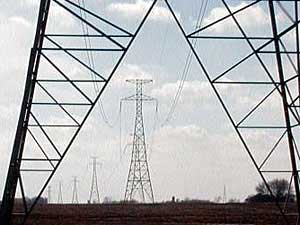ILSR’s Farrell on Fed Transmission Scam
June 29th, 2011
ILSR’s John Farrell is halfway there – he recognizes the federal part of the transmission equation, but the state part is missing, for example, Minnesota’s special eminent domain exemptions for “Public Service Corporations” (particularly where the transmission is for private profit, NOT public service), rate recovery for “Construction Work in Progress” and state regulators refusal to examine the interstate nature of transmission proposals. And the third part of that unholy trinity — in the Midwest, bulk power transmission would not be being built but for the Settlement Agreement – ME3(Fresh Energy), Izaak Walton League (and Walton’s program Wind on the Wires), Minnesota Center for Environmental Advocacy, and North American Water Office. This glut of transmission is their legacy. It takes all three to build transmission.
From Grist, today:
Feds running a high-voltage gravy train for power transmission
by John Farrell
28 Jun 2011 6:00 AM
Even as distributed generation shows economical and political advantages over centralized renewable energy, the Federal Energy Regulatory Commission (FERC) is running a high voltage gravy train in support of expanded transmission. FERC’s lavish program is expanding large transmission infrastructure at the expense of ratepayers instead of looking at more economical alternatives.Since 2007, FERC has had 45 requests for bonus incentives for transmission development — authorized under the 2005 Energy Policy Act — and has provided all or most of the requested incentives in more than 80 percent of the cases. With the bonuses, the average return on equity for utilities for their new transmission investments is nearly 13 percent. This high rate of return is a full 2.5 percentage points higher than the median utility return on equity [PDF], a value considered just and reasonable by state public service commissions in ordinary times. However, these rewards came during a time when unemployment doubled, the stock market tumbled, and most corporations were lucky to have any profit.The ratepayer impact of these bonuses is significant. In a November 2010 criticism of FERC transmission awards, Commissioner John Norris noted that the 2 percent bonus FERC provided to the PATH high-voltage project on the Eastern seaboard would “cost [Maryland] ratepayers in PJM at least $18 million per year.” The bonus payments were also given in concert with other incentives that reduced risk, including rate recovery during construction and guarantee of payment if the facilities were abandoned for reasons outside utility control.
FERC asserts that it uses the bonuses to help incentivize the development of new transmission to improve reliability and reduce congestion, but it doesn’t do its homework. Rather, FERC refuses to study more economical alternatives; doesn’t require the incentives to be necessary for the transmission development; and doesn’t even require that the proposed utility expenditures be prudent:
FERC [PDF]:
There is no requirement in section 219 or Order No. 679 that an applicant must demonstrate that its project is the best of all possible projects, or that it has explored every conceivable alternative before deciding to proceed with a particular project.
FERC [PDF]:
We note that [American Electric Power] is under no obligation under either FPA section 205 or FPA section 219 to establish that the incentives requested are necessary.
FERC [PDF]:
Moreover, the Commission generally does not require that utilities seeking to recover costs through their rates demonstrate initially that all expenditures for which they seek recovery were prudent. 76 Rather, participants in rate proceedings seeking to challenge the expenditures must first create a serious doubt as to the prudence of the expenditures before the burden shifts to the filing utility. 77 As stated in Order No. 679, “[t]he Commission is making no change in the long-standing regulatory presumption in a section 205 proceeding that costs are prudently incurred, but parties are free to provide evidence to the contrary … “
FERC also routinely hands out a 0.5 percent bonus incentive to every utility for participation in its respective regional transmission organization (RTO). This reward is given to every utility that asks for it, despite a Government Accountability Office report suggesting that the consumer benefits of such membership are unproven; and in one case, despite the fact that the requesting utility was already required by state law to participate in the RTO [PDF].
The most likely outcome of FERC’s lavish program for transmission development is a significant increase in utility shareholder profits at the expense of ratepayers, with only marginal improvements in the amount of available transmission capacity for new centralized renewable energy projects. The program may actually decrease utility interest in expanding transmission capacity [Powerpoint], because offering them a higher ROE increases the total cost of new infrastructure, decreasing the demand for it and reducing investment.
Even as it overpays for new transmission, FERC is throwing money at an outdated model of the electricity grid. Renewable energy is available everywhere, and states and communities have seen the opportunities of tapping it locally. Sixteen states have recognized the benefits of distributed generation by adopting solar or distributed generation-specific mandates [Powerpoint]. Communities encourage distributed generation for the increased economic benefits from locally-owned and developed projects. While some new transmission infrastructure is inevitable as the grid transitions to majority renewable power, most communities are interested in tapping their local resources first.
Transmission utilities are enjoying their ride on the high voltage gravy train, but ratepayers and citizens would be better served if FERC’s program derailed.
Note: much of this post is extracted from an earlier post on centralized vs.decentralized energy.
Grist, a beacon in the smog © 1999-2011 Grist Magazine, Inc. All rights reserved. Gloom and doom with a sense of humor. ©

Leave a Reply